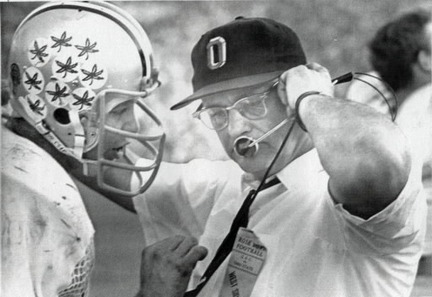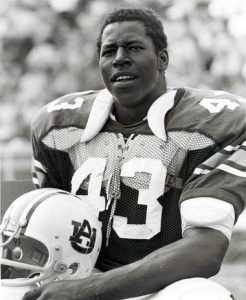
Rex Kern, the fearless leader of the 1968 Ohio State Buckeyes, stands beside the legendary coach Woody Hayes during one of the most dominant eras in college football history. This iconic image speaks volumes about a transformative moment in the sport and a partnership that helped forge one of the greatest dynasties the game has ever known. Kern, the cerebral and tough-as-nails quarterback, was the on-field extension of Hayes, a demanding and often uncompromising figure whose vision and grit molded Ohio State into a powerhouse.
Kern wasn’t just another player under Hayes—he was the centerpiece of the coach’s grand design. The 1968 season was supposed to be a rebuilding year. The Buckeyes were loaded with talent, but it was young, untested, and raw. That all changed when Kern, then a sophomore, took the reins of the offense. With poise beyond his years and a deep understanding of Hayes’ power-run system, he guided the team to a perfect 10-0 record, culminating in a resounding 27-16 victory over USC in the Rose Bowl. That win, which capped a national championship season, was the beginning of a remarkable run in which Ohio State went 27-2 over three years and won multiple Big Ten titles.
Kern’s performance on the field wasn’t just defined by statistics—though his numbers were impressive—but by leadership, resilience, and the ability to rise in the most pressure-filled moments. He had a knack for reading defenses, making crucial adjustments, and finding ways to win. While Hayes was famous for his disdain of passing, preferring to grind down opponents with an unforgiving run game, Kern found a way to thrive in the system. He added balance, occasionally stretching the field when needed, but always within the confines of Hayes’ disciplined philosophy.
The 1968 Buckeyes were affectionately known as the “Super Sophomores,” a moniker that hinted at both their youth and overwhelming potential. Alongside Kern, the team featured future legends like Jack Tatum, Jim Stillwagon, and John Brockington—players who would go on to become household names in college football and, for many, in the NFL. Yet even among such star power, Kern’s leadership was undeniable. Teammates revered him not just for what he did with the ball in his hands, but for how he commanded respect in the huddle, rallied the team through adversity, and represented the toughness and work ethic that Hayes demanded.
Woody Hayes was more than just a coach—he was an institution. Known for his fiery demeanor, intense preparation, and belief in “three yards and a cloud of dust,” Hayes could be as polarizing as he was brilliant. Yet he had a deep appreciation for players who shared his values, and in Rex Kern, he found a kindred spirit. Their relationship wasn’t always easy; Hayes pushed his players hard, and Kern was no exception. But through the fire came trust, and through the trust came results. Hayes often credited Kern’s mental toughness and leadership as the glue that held the Buckeyes together during this era.
Their bond represented a fascinating dynamic. Hayes, the stern disciplinarian with a vision rooted in physicality and mental fortitude, and Kern, the cool and collected leader who absorbed every lesson, every critique, and every moment as an opportunity to elevate his game. Kern’s understanding of the bigger picture—of what Hayes was trying to accomplish and what it took to win—was rare. He bought into the philosophy not because he had to, but because he believed in it. That belief translated into execution on Saturdays.
Beyond the national championship season, Kern led the Buckeyes to a 9-1 record in 1969, only losing to Michigan in a game that became the genesis of the Ten-Year War between Hayes and Bo Schembechler. The rivalry, already storied, took on new life, and Kern was right at the heart of it. Even in defeat, his grit stood out. He helped lead Ohio State to the Rose Bowl again in 1970 and 1971, becoming one of the few quarterbacks in college football history to play in three straight Rose Bowls.
Kern’s toughness extended beyond the field. Injuries were a constant companion throughout his career. He battled through shoulder problems, back issues, and numerous other ailments that would have sidelined less determined players. But Kern rarely complained. He played through the pain, showing the same resilience that made him a star in high school and a legend in college. That toughness was a reflection of Hayes’ mantra—mental toughness, loyalty, and playing for something bigger than oneself.
When fans look back at the late 1960s and early 1970s Buckeye teams, they see more than wins and titles. They see a culture, a mindset, a standard that was set by Hayes and executed by leaders like Kern. The legacy of that era isn’t just in the record books; it lives in the expectations that continue to surround Ohio State football to this day. Every time the Buckeyes take the field, they carry the spirit of those teams with them—the discipline, the fight, and the unwavering belief that anything is possible through hard work and unity.
The photo of Kern and Hayes captures more than just a quarterback and his coach—it’s a snapshot of college football history, of a program at its zenith, of a moment in time when the sport felt both raw and pure. It’s a reminder of what happens when preparation meets talent, when leadership is forged in the crucible of competition, and when mutual respect creates something greater than the sum of its parts.
Rex Kern’s post-football life has been marked by continued excellence and service. He was inducted into the College Football Hall of Fame and has remained a beloved figure in Columbus. His story is a testament to perseverance and humility, never seeking the spotlight, but always earning it. He embodies everything Ohio State fans admire: grit, intelligence, loyalty, and leadership.
Woody Hayes would go on to become one of the most revered and controversial figures in college football. His career ended in scandal, but his impact is undeniable. For every outburst and headline, there were also moments of mentorship, lessons imparted, and young men molded into leaders. And perhaps no player reflected Hayes’ best qualities more than Rex Kern.
Their time together was brief in the grand scheme of things—just three seasons—but the impact has echoed for decades. It was a partnership built on trust, forged in battle, and sealed in victory. The 1968 championship remains one of the crowning achievements in Ohio State history, and Rex Kern’s role in that triumph will never be forgotten.
As the game continues to evolve, as offenses spread out and rules change to favor high-flying attacks, there remains a place in the heart of every Buckeye fan for the power-run days, for the grinding drives and the punishing defenses, and for the quarterback who made it all work. Rex Kern wasn’t the flashiest player. He didn’t need to be. He was the heart, the soul, the unshakable force that held everything together.
And beside him stood Woody Hayes, the architect of it all, a man who demanded everything from his players and gave them everything in return. Together, they crafted not just victories, but a legacy. The image of the two of them—Kern with his calm focus, Hayes with his unrelenting intensity—tells the story better than any stat line ever could. It tells the story of a golden age, of a team that became a family, and of two men whose bond helped shape the destiny of Ohio State football.





